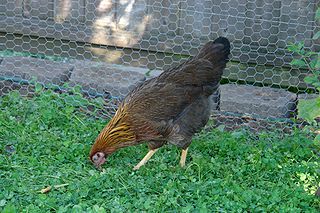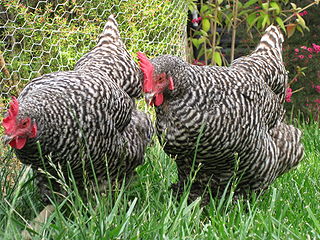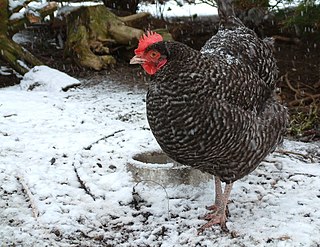
The American Game is an American breed of game fowl, chickens bred specifically for cockfighting. It has many color varieties, and may also be kept for ornament.

The Welsummer or Welsumer is a Dutch breed of domestic chicken. It originates in the small village of Welsum, in the eastern Netherlands. It was bred at the beginning of the twentieth century from local fowls of mixed origin: Rhode Island Reds, Barnevelders, Partridge Leghorns, Cochins, and Wyandottes. In 1922–23, steps were taken to fix a standard after the birds began to show a good deal of uniformity. The eggs were originally exported for the commercial egg trade. Some stock was exported to the United Kingdom, and the breed was added to the British Standard in 1930.

The Orpington is a British breed of chicken. It was bred in the late nineteenth century by William Cook of Orpington, at that time in Kent in south-east England. It was intended to be a dual-purpose breed, to be reared both for eggs and for meat, but soon became exclusively a show bird. The Australorp of Australia derives from it.

The Barnevelder is a Dutch breed of domestic chicken. It resulted from cross-breeding between local Dutch chickens and various "Shanghai" birds imported from Asia to Europe in the later part of the nineteenth century; these may have been of Brahma, Cochin or Croad Langshan type. It is named for the town and gemeente (municipality) of Barneveld, in Gelderland in the central Netherlands. The hens are good layers of large brown eggs and, unlike some other breeds, continue to lay well during winter.

The Dorking is a British breed of domestic chicken. It is named after the town of Dorking, in Surrey in southern England.

The Australorp is an Australian breed of dual-purpose utility chicken. It derives from the British Black Orpington, and was selectively bred for egg-laying performance; some hens lay more than 300 eggs per year. It achieved world-wide popularity in the 1920s after the breed broke numerous world records for number of eggs laid and has been a popular breed in the western world since. It is one of eight poultry breeds created in Australia and recognised by the Australian Poultry Standards. The original plumage colour is black, which is the only colour recognised in the United States of America, but blue and white are also recognised in Australia and the Poultry Club South Africa recognises buff, splash, wheaten laced and golden in addition.

The Brahma is an American breed of chicken. It is believed that it was first bred in the United States from birds imported from the Chinese port of Shanghai, and was the principal American meat breed from the 1850s until about 1930.

The Pekin Bantam is a British breed of bantam chicken. It derives from birds brought to Europe from China in the nineteenth century, and is named for the city of Peking where it was believed to have originated. It is a true bantam, with no corresponding large fowl. It is recognised only in the United Kingdom, where the Cochin has no recognised bantam version; like the Cochin, it has heavy feathering to the legs and feet. The Entente Européenne treats the Pekin Bantam as equivalent to the bantam Cochin.

The Malay Game is a breed of game chicken. It is among the tallest breeds of chicken, and may stand over 90 cm high.

The Sussex is a British breed of dual-purpose chicken, reared both for its meat and for its eggs. Eight colours are recognised for both standard-sized and bantam fowl. A breed association, the Sussex Breed Club, was organised in 1903.

The Plymouth Rock is an American breed of domestic chicken. It was first seen in Massachusetts in the nineteenth century and for much of the early twentieth century was the most widely kept chicken breed in the United States. It is a dual-purpose bird, raised both for its meat and for its brown eggs. It is resistant to cold, easy to manage, and a good sitter.

The Japanese Bantam or Chabo is a Japanese breed of ornamental chicken. It is a true bantam breed, meaning that it has no large fowl counterpart. It characterised by very short legs – the result of hereditary chondrodystrophy – and a large upright tail that reaches much higher than the head of the bird.

The Marans, French: Poule de Marans, is a French breed of dual-purpose chicken, reared both for meat and for its dark brown eggs. It originated in or near the port town of Marans, in the département of Charente-Maritime, in the Nouvelle-Aquitaine region of south-western France.

The Wyandotte is an American breed of chicken developed in the 1870s. It was named for the indigenous Wyandot people of North America. The Wyandotte is a dual-purpose breed, kept for its brown eggs and its yellow-skinned meat. It is a popular show bird, and has many color variants. It was originally known as the American Sebright.

The Sebright is a British breed of bantam chicken. It is a true bantam – a miniature bird with no corresponding large version – and is one of the oldest recorded British bantam breeds. It is named after Sir John Saunders Sebright, who created it as an ornamental breed by selective breeding in the early nineteenth century.

The Dutch Bantam is a breed of bantam chicken originating in the Netherlands. It is a true bantam, a naturally small bird with no related large fowl from which it was miniaturized. It is kept mainly for exhibition, and has been bred in many color varieties; it is a good layer of small eggs.

The Modern Game is a British breed of ornamental chicken which originated in England between 1850 and 1900. It was bred from gamecock stock, but solely as an exhibition bird.
The Nankin Bantam or Nankin is a British bantam breed of chicken. It is a true bantam, a naturally small breed with no large counterpart from which it was miniaturised. It is of South-east Asian origin, and is among the oldest bantam breeds. It is a yellowish buff colour, and the name is thought to derive from the colour of nankeen cotton from China.

The Booted Bantam or Dutch Booted Bantam is a European breed of true bantam chicken. It is characterised by abundant feathering on the feet and shanks, which gives it a "booted" appearance; and by vulture hocks, long stiff downward-pointing feathers on backs of the thighs, from which the Dutch name Sabelpoot ("sabre-legged") derives.

The Appenzeller Barthuhn is a Swiss breed of bearded chicken originating in the historical Appenzell region of Switzerland. It is one of two chicken breeds from that area, the other being the Appenzeller Spitzhauben; the only other Swiss breed of chicken is the Schweizer.
























